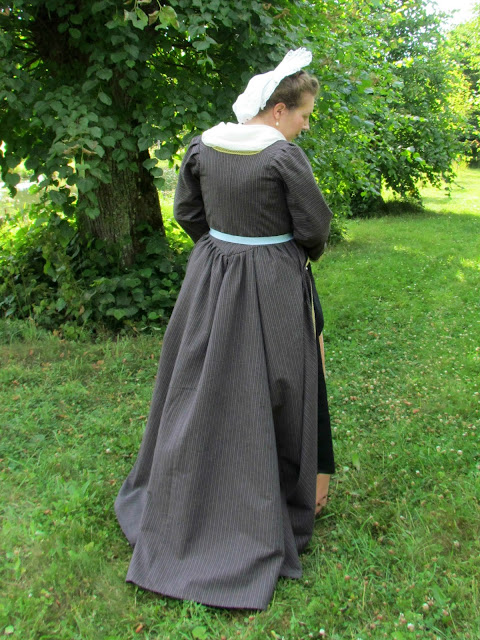The Challenge: Travels.
Fabric: Double sided wool, striped in grey/blue/brown on one side, black on the other. Brown linen for lining.
Pattern: I adapted my basic 18th century bodice and sleeve pattern while trying to keep to the proportions of the original pattern diagram. The skirt is made of four half trapezoid pattern pieces. The skirt was drafted directly onto the fabric, using the same angles as the pattern diagram.
Year: 1690-1712
Notions: Gold braid. Sewing silk in black, brown, blue and pale gold. Grosgrain ribbon in pale blue rayon. Antique paste belt buckle.
How historically accurate is it? I would say 75 %. The pattern is based on original sources, but due to fabric shortage I had to do a few changes on the skirt. The original skirt length was the back bodice length multiplied with three, which would have given the skirt a longer trail. The measurements of the skirt was double the waist measurement, but the front has much less fabric, I’m sorry to say. I sew it all together on machine, but all other seams were made by hand.
The gown turned out too big, partly because I’ve lost weight, but probably also because wool is stretchy. Even if I’m quite pleased with it, I’ll need to do some changes for a better fit. I also need to drape up the skirt more toward the back when I wear it. The fontange cap was made after a self drafted pattern, using these instructions. I thought it was too narrow on top, but it looked fine when I actually wore it. I used fine linen and remnants of lace my grandmother made. I need to purchase lace for the lapels and add a bow on the back. I also made a first try for the proper hairstyle and I Think it turned out ok. Not as high as I wanted it, but I merely worked with curled hair. Next time I'll see what pomade and powder can do.
Hours to complete: Cant’s say. The cutting, fitting and sewing it all together took about five hours. Then came all that hand sewing.
First worn: Yesterday at an 18th century picknick.
Total cost: 4 meter of wool fabric; 77 Euro. Belt buckle; 7 Euro. 4 meter of gold braid; 23 Euro. The brown linen was the gift from an aunt and originally purchased in the 1980’s. The grosgrain ribbon and the silk thread was inherited from my grandmother. So I guess the total cost would be 110-115 Euro.
This kind of gown can be seen on paintings and fashion plates in the late 17th/early 18th century. Though the skirt is slit and draped the same way as a mantua, the bodice is smooth and not fitted with the help of pleats.
 |
| Anne Marie d'Orléans while Duchess of Savoy by L. Mariette, 1684 |
 |
| Anne de Souvré, marquise de Louvois (1646-1715) by Simon Dequoy, 1695 |
 |
| Anonymous portrait, 1680-1700, Nordiska museet |
 |
| Recueil des modes de la cour de France, 'Fille de qualité', 1680 |
 |
| The Cryes of the City of London Drawne after the Life: Fair Lemons & Oranges, 1688 |
 |
| The Cryes of the City of London Drawne after the Life: Crab crab any crab, 1688 |


